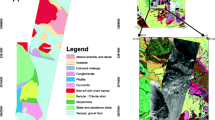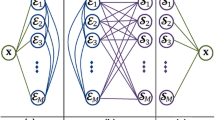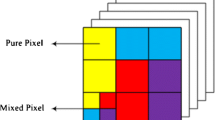Abstract
Hyperspectral datasets are usually composed of different pure materials or endmembers. Endmember extraction is the most challenging stage in the spectral unmixing procedure. In the case of mineral detection studies, due to the absence of pure pixels for some constituent minerals, the common methods based on pure pixel assumption do not yield accurate results. The current study aims to evaluate the efficiency of ORASIS in endmember determination. ORASIS is a collection of stepwise algorithms working together to produce a set of endmembers not necessarily included in the dataset. The ORASIS method was applied to estimate the endmembers of three hyperspectral dataset series: 1) highly mixed synthetic dataset with maximum purity of 0.48 %, 2) AVIRIS dataset of Cuprite, Nevada, 3) Hyperion dataset of the Dost-Bayli area, Ardabil. SAM and SFF techniques were used to identify the unknown endmembers by comparison of them with USGS spectral library. The functionality of the VCA and PPI as pure pixel-based approaches were also investigated along with ORASIS. The number of estimated endmembers of ORASIS that were appropriately matched with reference spectra was more than VCA and PPI so that majority of detected minerals are present in the study areas. So, it can be inferred that ORASIS generally outperforms the VCA and PPI. The Linear Spectral Unmixing algorithm was implemented for demixing of the Cuprite and Dost-Bayli datasets; and abundances maps were generated using mapping methods. The results highly correspond to the geological, geochemical and mineralogical reports of both regions.







Similar content being viewed by others
References
Baniadam, F. (2008). Report of promising regions of 1:100000 geological map of lahrud. Tehran, Iran: Geological Survey of Iran.
Boardman, J. W., Kruse, F. A., & Green, R. O. (1995). Mapping target signatures via partial unmixing of aviris data. Fifth JPL Airborne Earth Science Workshop, 95, 23–26.
Borengasser, M., Hungate, W. S., & Watkins, R. (2008). Hyperspectral remote sensing, principles and applications. New York: CRC Press, Taylor & Francis Group.
Chan, T. H., Chi, C. Y., Huang, Y. M., & Ma, W. K. (2009). A convex analysis-based minimum volume enclosing simplex algorithm for hyperspectral unmixing. IEEE Transactions on Signal Processing, 57(11), 4418–4432.
Chang, C. I. (2007). Hyperspectral data exploitation: theory and applications. New Jersey: Wiley-Interscience.
Clark, R. N., Boardman, J., Mustard, J., Kruse, F., Ong, C., Pieters, C., & Swayze, G. A. (2006). Mineral mapping and applications of imaging spectroscopy. IEEE International Geoscience and Remote Sensing Symposium, 1, 1986–1989.
Crowley, J. K., & Vergo, N. (1988). Near-infrared reflectance spectra of mixtures of kaolin-group minerals; use in clay mineral studies. Clays and Clay Minerals, 36(4), 310–316.
Cui, J., Li, X., & Zhao, L. (2011). Linear mixture analysis for hyperspectral imagery in the presence of less prevalent materials. IEEE Transactions on Geoscience and Remote Sensing, 51(7), 4019–4031.
Dias, J. M. B. (2009). A variable splitting augmented lagrangian approach to linear spectral unmixing. Hyperspectral Image and Signal Processing: Evolution in Remote Sensing. doi:10.1109/WHISPERS.2009.5289072.
Goodenough, D. G., Dyk, A., Niemann, K. O., Pearlman, J. S., Chen, H., Han, T., Murdoch, M., & West, C. (2003). Processing hyperion and ALI for forest classification. Geoscience and remote sensing. IEEE Transactions on, 41(6), 1321–1331.
Hoffbeck, J. P., & Landgrebe, D. A. (1996). Classification of remote sensing images having high spectral resolution. Remote Sensing of Environment, 57(3), 119–126.
Iordache, M. D., Dias, J. M. B., Plaza, A., & Somers, B. (2014). MUSIC-CSR: Hyperspectral unmixing via multiple signal classification and collaborative sparse regression. IEEE Transactions on Geoscience and Remote Sensing, 52(7), 4364–4382.
Keshava, N. (2003). A survey of spectral unmixing algorithms. Lincoln Laboratory Journal, 14(1), 55–78.
Kruse, F. A., Boardman, J. W., & Huntigton, J. F. (2003). Comparison of airborne hyperspectral data and eo-1 hyperion for mineral mapping. IEEE Transactions on Geoscience and Remote Sensing, 41(6), 1388–1400.
Li, J., & Dias, J. M. B. (2008). Minimum volume simplex analysis: a fast algorithm to unmix hyperspectral data. IEEE International Geoscience and Remote Sensing Symposium, 3, 250–253.
Miao, L., & Qi, H. (2007). Endmember extraction from highly mixed data using minimum volume constrained nonnegative matrix factorization. IEEE Transactions on Geoscience and Remote Sensing, 45(3), 765–777.
Nascimento, J. M. P., & Dias, J. M. B. (2005). Vertex component analysis: a fast algorithm to unmix hyperspectral data. IEEE Transactions on Geoscience and Remote Sensing, 43(4), 898–910.
Neville, R., Staenz, K., Szeredi, T., Lefebvre, J., & Hauff, P. (1999). Automatic endmember extraction from hyperspectral data for mineral exploration. Presented at the fourth international airborne remote sensing conference and exhibition, 21st Canadian symposium on remote sensing, Ottawa, Ontario, Canada, June 21–24.
Plaza, A., Martinez, P., Perez, R., & Plaza, J. (2004). A quantitative and comparative analysis of endmember extraction algorithms from hyperspectral data. IEEE Transactions on Geoscience and Remote Sensing, 42(3), 650–663.
Plaza, A. J., & Chang, C. I. (2007). High performance computing in remote sensing. Boca Raton, FL, USA: Chapman & Hall/CRC.
Plaza, J., & Hendrix, E. M. T. (2011). On endmember identification in hyperspectral images without pure pixels: a comparison of algorithms. Journal of Mathematical Imaging and Vision, 42(2–3), 163–175.
Riaño, D., Chuvieco, E., Salas, J., & Aguado, I. (2003). Assessment of different topographic corrections in landsat-tm data for mapping vegetation types. IEEE Transactions on Geoscience and Remote Sensing, 41(5), 1056–1061.
Swayze, G. A., Clark, R. N., Goetz, A. F. H., Chrien, T. G., & Gorelick, N. S. (2003). Effects of spectrometer band pass, sampling, and signal-to-noise ratio on spectral identification using the tetracorder algorithm. Journal of Geophysical Research, 108(E9), 5105. doi:10.1029/2002JE001975.
Winter, M. E. (1999). N-FINDR: an algorithm for fast autonomous spectral end-member determination in hyperspectral data. SPIE Conference on Imaging Spectrometry V, 3753, 266–275.
Winter, M. E. (2004). A proof of the N-FINDR algorithm for the automated detection of endmembers in a hyperspectral image. SPIE Conference on Algorithms and Technologies for Multispectral, Hyperspectral, and Ultraspectral Imagery, 5425, 31–41.
Author information
Authors and Affiliations
Corresponding author
About this article
Cite this article
Nouri, T., Oskouei, M.M. & Zekri, H. A Comparison Study of ORASIS and VCA for Mineralogical Unmixing of Hyperspectral Data. J Indian Soc Remote Sens 44, 723–733 (2016). https://doi.org/10.1007/s12524-015-0546-1
Received:
Accepted:
Published:
Issue Date:
DOI: https://doi.org/10.1007/s12524-015-0546-1




